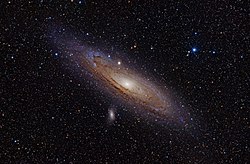Andromeda I
| Galaxie Andromeda I | |
|---|---|
 | |
| Andromeda I, aufgenommen durch das Hubble-Weltraumteleskop | |
| AladinLite | |
| Sternbild | Andromeda |
| Position Äquinoktium: J2000.0, Epoche: J2000.0 | |
| Rektaszension | 00h 45m 39,8s[1] |
| Deklination | +38° 02′ 28″ [1] |
| Erscheinungsbild | |
| Morphologischer Typ | E3 pec/dSph [1] |
| Helligkeit (visuell) | 13,6 mag [1] |
| Winkelausdehnung | 2,5′ × 2,5′ [1] |
| Physikalische Daten | |
| Rotverschiebung | −0,001228 ± 0,000037 [1] |
| Radialgeschwindigkeit | (−368 ± 11) km/s [1] |
| Entfernung | (2.400.000 ± 80.000) Lj / (735.000 ± 23.000) pc [2][3][4] |
| Geschichte | |
| Entdeckung | Sidney van den Bergh |
| Entdeckungsdatum | 1970 |
| Katalogbezeichnungen | |
| PGC 2666 • And I,[2] Anon 0043+37,[1] | |
Andromeda I ist eine spheroidale Zwerggalaxie (dSph) im Sternbild der Andromeda.[5] Die Galaxie ist etwa 2,4 Millionen Lichtjahre von unserem Sonnensystem entfernt.[4] Andromeda I ist Mitglied der Lokalen Gruppe und ist ein Satellit der Andromedagalaxie (M31).
Eigenschaften
Die Zwerggalaxie befindet sich grob 3,5 Grad südlich und leicht östlich von M31.[6] Sie ist damit Stand des Jahres 2005 die sich am nächsten befindliche Satellitengalaxie Andromedas[7] mit einer geschätzten projizierten Entfernung von etwa 40 kpc[4] oder 150.000[6] Lichtjahren.
Andromeda I wurde im Jahr 1970 von Sidney van den Bergh[8] mit dem 1,2 m Oschin-Schmidt-Teleskop auf dem Palomar-Observatorium entdeckt.[5] Weitere Untersuchungen an Andromeda I wurden mit der Wide Field/Planetary Camera 2 des Hubble-Weltraumteleskops vorgenommen.
Diese fanden wie bei anderen spheroidalen Zwerggalaxien auch eine hauptsächlich von Roten Riesen dominierten Horizontalast.[9] Dadurch und die zusätzliche Bestimmung der Häufigkeit der blauen Sterne am Horizontalast sowie die Entdeckung von 99 RR-Lyrae-Sternen im Jahr 2005[7] konnte man zeigen, dass Andromeda I eine ausgedehnte Ära der Sternentstehung von etwa abgeschätzten 10 Milliarden Jahren durchlebte. Das Hubble-Teleskop entdeckte darüber hinaus einen Kugelsternhaufen als Begleiter von Andromeda I, was sie zur lichtschwächsten Galaxie mit einem derartigen Trabanten macht.[10]
Weiteres
Einzelnachweise
- ↑ a b c d e f NASA/IPAC Extragalactic Database. In: Results for Andromeda I. Abgerufen am 21. Januar 2008.
- ↑ a b I. D. Karachentsev, V. E. Karachentseva, W. K. Hutchmeier, D. I. Makarov: A Catalog of Neighboring Galaxies. In: Astronomical Journal. Band 127, Nr. 4, 2004, S. 2031–2068, doi:10.1086/382905, bibcode:2004AJ....127.2031K.
- ↑ I. D. Karachentsev, O. G. Kashibadze: Masses of the local group and of the M81 group estimated from distortions in the local velocity field. In: Astrophysics. Band 49, Nr. 1, 2006, S. 3–18, doi:10.1007/s10511-006-0002-6, bibcode:2006Ap.....49....3K.
- ↑ a b c A. W. McConnachie, M. J. Irwin, A. M. N. Ferguson, R. A. Ibata, G. F. Lewis, N. Tanvir: Determining the location of the tip of the red giant branch in old stellar populations: M33, Andromeda I and II. In: Monthly Notices of the Royal Astronomical Society. Band 350, Nr. 1, Mai 2004, S. 250, doi:10.1111/j.1365-2966.2004.07637.x, arxiv:astro-ph/0401453, bibcode:2004MNRAS.350..243M.
- ↑ a b Sidney van den Bergh: Search for Faint Companions to M31. In: Astrophysical Journal. Band 171, Januar 1972, S. L31, doi:10.1086/180861, bibcode:1972ApJ...171L..31V.
- ↑ a b Andromeda I. In: Students for the Exploration and Development of Space (SEDS). 25. Juli 2001 (seds.org).
- ↑ a b Barton J. Pritzl, Taft E. Armandroff, George H. Jacoby, G. S. Da Costa: The Dwarf Spheroidal Companions to M31: Variable Stars in Andromeda I and Andromeda III. In: The Astronomical Journal. Band 129, Nr. 5, Mai 2005, S. 2232–2256, doi:10.1086/428372, arxiv:astro-ph/0501083, bibcode:2005AJ....129.2232P.
- ↑ A. W. McConnachie, M. J. Irwin, A. M. N. Ferguson, R. A. Ibata, G. F. Lewis, N. Tanvir: Distances and metallicities for 17 Local Group galaxies. In: Monthly Notices of the Royal Astronomical Society. Band 356, Nr. 4, 2005, S. 979–997, doi:10.1111/j.1365-2966.2004.08514.x, arxiv:astro-ph/0410489, bibcode:2005MNRAS.356..979M.
- ↑ G. S. Da Costa, T. E. Armandroff, Nelson Caldwell, Patrick Seitzer: The Dwarf Spheroidal Companions to M31: WFPC2 Observations of Andromeda I. In: Astronomical Journal. Band 112, Dezember 1996, S. 2576, doi:10.1086/118204, arxiv:astro-ph/9610083, bibcode:1996AJ....112.2576D.
- ↑ E. K. Grebel, A. E. Dolphin, P. Guhathakurta: Discovery of a Globular Cluster in M31's Dwarf Spheroidal Companion Andromeda I. In: Astronomische Gesellschaft Abstract Series. Band 17, Abstracts of Contributed Talks and Posters presented at the Annual Scientific Meeting of the Astronomische Gesellschaft, 18. September 2000, bibcode:2000AGM....17..P61G.
Weblinks
Auf dieser Seite verwendete Medien
Autor/Urheber: Adam Evans, Lizenz: CC BY 2.0
Die Andromedagalaxie ist eine Spiralgalaxie im Sternbild Andromeda (etwa 2,4 bis 2,9 Millionen Lichtjahre entfernt). Das Foto zeigt auch die Messierobjekte 32 und 110 sowie NGC 206 (eine helle Sternassoziation in der Andromedagalaxie) und den Stern ν Andromedae. Kombination von LRGB- und Hα-Bilddaten.
Andromeda I dwarf galaxy by Hubble space telescope





